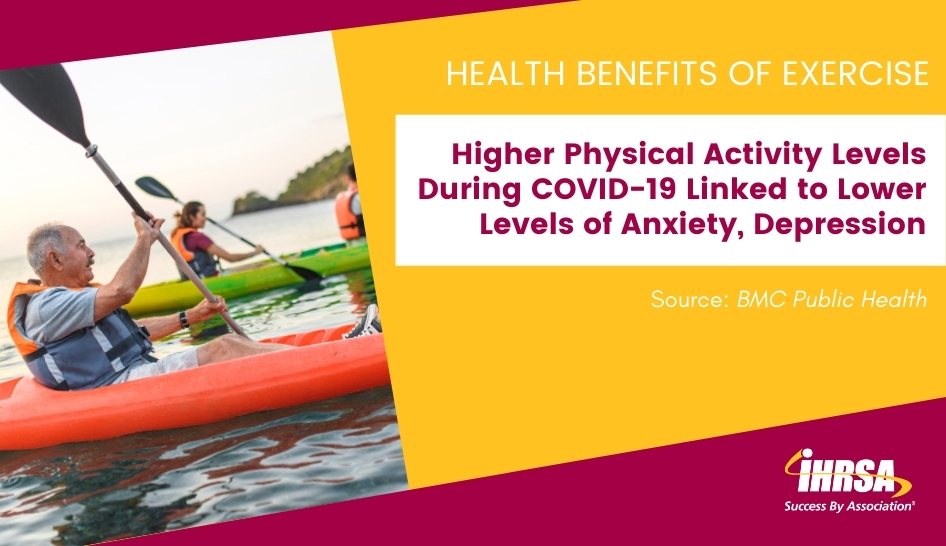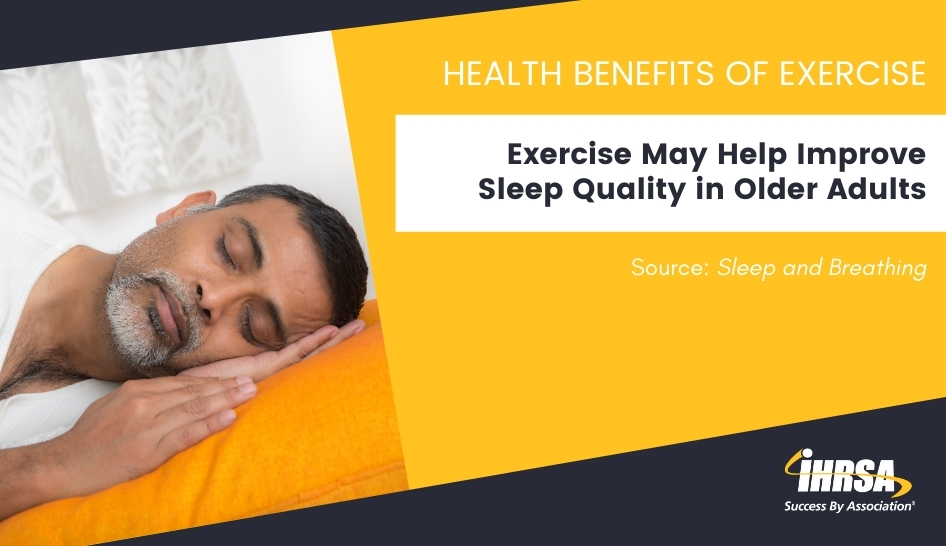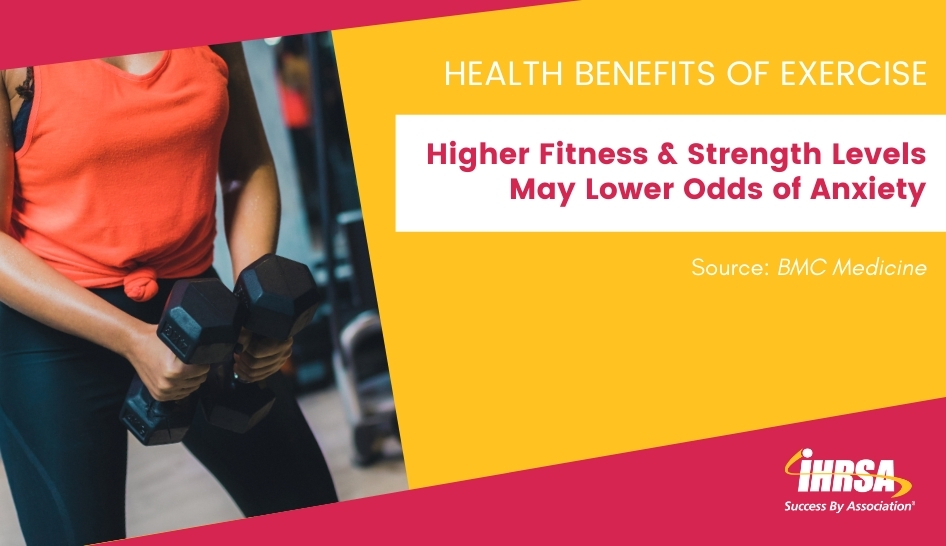The Health Benefits of Exercise Report is a newsletter and article series in which we select three peer-reviewed articles, summarize the key findings, and provide social media images for you to share with your community. You can read previous articles here.
Physical Activity During COVID-19 Linked to Mood
We review three studies that show a link between low physical activity during COVID-19 to anxiety and depression, the potential for exercise to improve sleep quality in older adults, and how higher objectively measured fitness and strength levels lower the odds of anxiety and depression.
The COVID-19 pandemic may show signs of improvement in some areas, but maintaining a physically active lifestyle continues to present a challenge. We know that exercise is a key measure to maintaining good physical and mental health and well-being. This month’s edition of the Health Benefits of Exercise Report covers:
- A study finding a link between physical activity during the COVID-19 pandemic and anxiety and depression,
- A narrative review discussing the potential for exercise as a strategy to improve sleep in older adults, and
- A study showing an association between higher aerobic fitness and grip strength and lower odds of anxiety and depression symptoms.

Higher Physical Activity Levels During COVID-19 Linked to Lower Levels of Anxiety, Depression
Physical inactivity was an existing global concern. In early 2020, restrictions associated with COVID-19 significantly decreased physical activity opportunities in many parts of the world, for example, closing fitness centers and limiting community movement. A study conducted in Brazil and published in BMC Public Health looked at the associations between physical distancing measures and activity levels and the relationship between mood and physical activity, income, and other factors like age and sex. Researchers recruited participants to complete a questionnaire through online advertising between June 2 - 12, 2020. In total, 2,140 people filled out the survey, providing demographic information and answering questions about physical activity habits, quarantine behaviors, and mood.
According to the findings, for many, physical activity was lower during the social distancing period than prior—69% of respondents reported activity levels classified as “very active” before social distancing, which dropped to 39% with the addition of social distancing. The number of people who were insufficiently active or inactive increased by 147%. Roughly 30% of people reported moderate or severe depressive symptoms, and 23.3% reported moderate or severe anxiety symptoms amid social distancing. There were statistically significant links between depression and anxiety scores and lower physical activity levels, lower monthly income, and age, with the oldest and youngest groups reporting more significant symptoms. A higher than expected number of people in the “very active” classification reported minimal depression symptoms and no anxiety.
A fundamental limitation to these results is that the survey did not ask about anxiety or depression before the pandemic, so it is unclear if or how the institution of COVID-19 restrictions affected mood compared to before. While, as the authors note, Brazil had higher levels of depression compared to global incidence prior to the pandemic, these findings are consistent with other studies showing higher depression levels amid the pandemic, and an association between physical activity and mental health, as well as economic anxiety and mental health.
The authors conclude, “Considering the dramatic change in lifestyle linked to physical inactivity and all non-communicable diseases associated with this condition, such as diabetes, cardiovascular disease, and obesity as well as the significant association between physical inactivity and mental diseases, it is clear that people during this social distancing period are becoming much more physically and mentally vulnerable, which affects their ability to combat a possible COVID-19 infection. Therefore, physical activity programs should be encouraged, given that they respect the required social distancing to contain the spread of SARS-CoV-2.”

Exercise May Help Improve Sleep Quality in Older Adults
Both the quantity and quality of sleep can decline with age, and estimates suggest insomnia could affect as many as 25% of older adults. There’s a debate between scientists as to why this is. Some believe this is because sleep requirements also decline with age, while others attribute it to a lost ability to get restorative sleep. However, research seems to favor the need for sleep as we age and suggests sleep issues may result from physiological changes that can make it harder for the brain to produce restorative sleep. A review published in the journal Sleep and Breathing discusses sleep issues in older adults and the potential use of exercise and other non-pharmacological interventions to improve sleep.
The authors point to a body of evidence that moderate-intensity exercise is most effective in improving sleep parameters. Additionally, sleep may be associated with physical activity performance the next day. The review highlights one study including 11 women finding that improved sleep may encourage exercise participation the following day. The evidence is less clear when it comes to resistance training alone. The interactions between physical activity and sleep are complex and may be influenced by factors including:
- immune function,
- anxiety,
- quality of life,
- sunlight exposure, and
- sedentary time.
Given the many other physical and mental health benefits of physical activity, research should continue to explore its potential as a tool to improve sleep quality in older adults.

Higher Fitness & Strength Levels May Lower Odds of Anxiety
Existing evidence points to a relationship between physical activity and mental health, but many studies rely on self-reported physical activity measures. A study published in the journal BMC Medicine looked at the relationship between objectively measured cardiorespiratory fitness and grip strength, and mental health. The researchers analyzed data on over 152,000 participants in a more extensive, UK-based cohort study.
According to the findings, the odds of depression were higher in people with low and medium compared to high fitness levels and grip strength. There’s also a link between low cardiorespiratory fitness levels and grip strength and higher odds of anxiety. When combined, people in the lowest category for grip strength and cardiovascular fitness had nearly double odds of depression and 1.6 times the odds of anxiety as those in the highest fitness and strength categories.
This study underlines the importance of movement generally and the benefits of achieving higher levels of cardiorespiratory fitness and muscular strength to benefit mental health. According to the study authors, “This finding highlights the importance of focusing on multiple components of fitness and their associations with mental health.”

Alexandra Black Larcom, MPH, RD, LDN, previously served as IHRSA's Senior Manager of Health Promotion & Health Policy—a position dedicated to creating resources and projects to help IHRSA members offer effective health programs, and promoting policies that advance the industry.